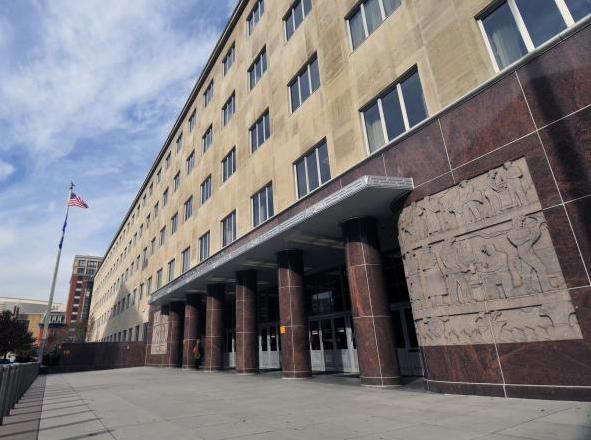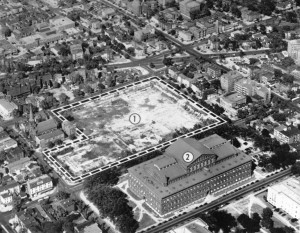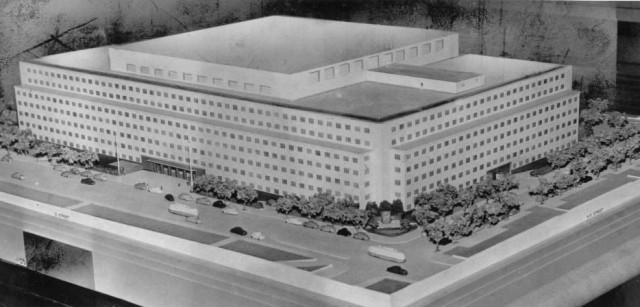GAO Headquarters, a Building Ahead of Its Time
 Did you know the design of GAO’s headquarters building was a novel concept? In December 1995, the National Park Service recognized the building for introducing modern architecture to the federal government. Here are 5 facts you may not know about the history of our building:
Did you know the design of GAO’s headquarters building was a novel concept? In December 1995, the National Park Service recognized the building for introducing modern architecture to the federal government. Here are 5 facts you may not know about the history of our building:
-
[caption id="attachment_956" align="alignright" width="150"]
 GAO's former home[/caption]
Our current headquarters building is across the street from its previous location.
Starting in 1926, many of GAO’s employees were headquartered in the Pension Building, so called because it formerly housed an agency that administered military pensions. Employees moved across G Street to the new building in 1951. In 1980, Congress designated the old Pension Building as the site of the National Building Museum.
GAO's former home[/caption]
Our current headquarters building is across the street from its previous location.
Starting in 1926, many of GAO’s employees were headquartered in the Pension Building, so called because it formerly housed an agency that administered military pensions. Employees moved across G Street to the new building in 1951. In 1980, Congress designated the old Pension Building as the site of the National Building Museum.
-
[caption id="attachment_957" align="alignright" width="264"]
 Photo from the Washington Star Collection, Washingtoniana Division, D.C. Public Library[/caption]
World War II stopped construction of the GAO building.
By the 1940s, our offices were scattered in 21 different buildings across Washington, DC, and northern Virginia, including the Pension Building. Plans to consolidate employees into one building were in progress. However, once the United States entered World War II in December 1941, construction on our building stopped because government resources were focused on wartime efforts.
Photo from the Washington Star Collection, Washingtoniana Division, D.C. Public Library[/caption]
World War II stopped construction of the GAO building.
By the 1940s, our offices were scattered in 21 different buildings across Washington, DC, and northern Virginia, including the Pension Building. Plans to consolidate employees into one building were in progress. However, once the United States entered World War II in December 1941, construction on our building stopped because government resources were focused on wartime efforts.
- GAO’s modern design marked a distinct break from typical federal office buildings.
The original design for our headquarters featured traditional interior courtyards and wings to provide optimal air and light. After the war, public work officials proposed a new design—a block style building with air conditioning.
[caption id="attachment_960" align="alignnone" width="640"]
 An image of the original 1941 design for the GAO building, prior to U.S. entry into World War II.[/caption]
An image of the original 1941 design for the GAO building, prior to U.S. entry into World War II.[/caption]
- The building had modern features at the time it opened.
In 1951, the GAO building was the largest air-conditioned structure in the capital city. It also had escalators that functioned until the early 1990s.
[caption id="attachment_959" align="alignnone" width="640"]
 Model of the GAO Building from 1949[/caption]
Model of the GAO Building from 1949[/caption]
- The center of the building was originally intended for storage space. When it was built, offices were located along the building’s perimeter, and the interior space was used to store government vouchers. As our focus broadened to include services beyond voucher auditing, central storage was no longer needed and was replaced with offices.
- Questions on the content of this post? Contact Chuck Young at youngc1@gao.gov.
- Comments on the WatchBlog? Contact blog@gao.gov.

GAO's mission is to provide Congress with fact-based, nonpartisan information that can help improve federal government performance and ensure accountability for the benefit of the American people. GAO launched its WatchBlog in January, 2014, as part of its continuing effort to reach its audiences—Congress and the American people—where they are currently looking for information.
The blog format allows GAO to provide a little more context about its work than it can offer on its other social media platforms. Posts will tie GAO work to current events and the news; show how GAO’s work is affecting agencies or legislation; highlight reports, testimonies, and issue areas where GAO does work; and provide information about GAO itself, among other things.
Please send any feedback on GAO's WatchBlog to blog@gao.gov.
